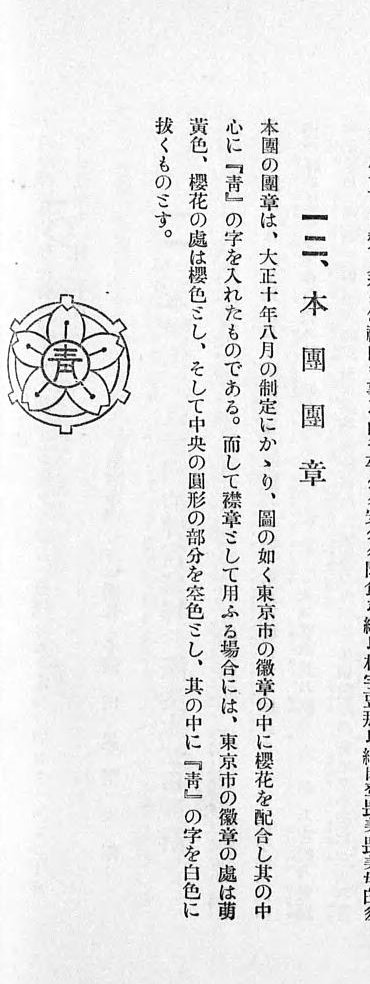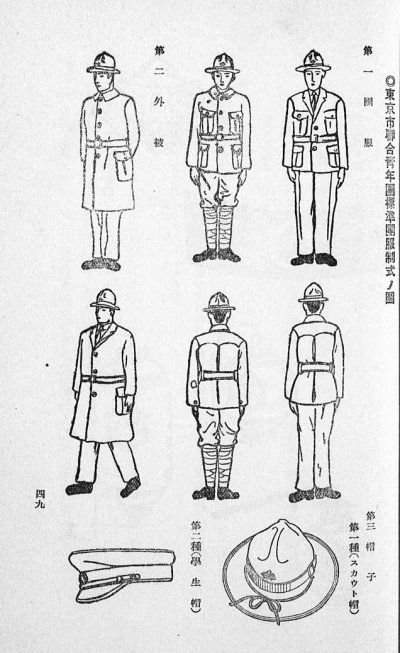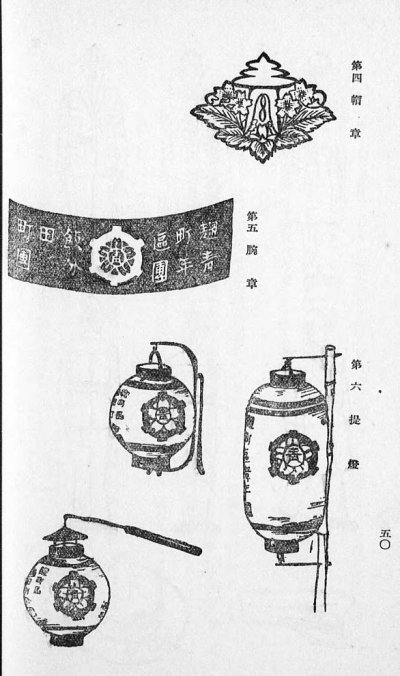青年団 - Seinen-dan
where
青年 - youth
団 /traditional form 團/ - league; association; union; group.
 ja.wikipedia.org
ja.wikipedia.org
Short history of this organization.
Source.

Uniform and insignia regulaions.



Flag and hymn.

where
青年 - youth
団 /traditional form 團/ - league; association; union; group.
青年団 - Wikipedia
Short history of this organization.
Among the many semi-governmental institutions that Japanese bureaucrats supervised in the pre–World War II era, the seinendan (village youth associations) were among the most impressive successes in terms of their scale. By the 1920s, almost every village had a seinendan, which included virtually all eligible people - young men between their early teens and late twenties who had completed elementary school. Their national network spread like a cobweb, and county-, prefecture-, and nation-level federations regularly organized sport and training events.
For state officials eager to reach the rural masses, the seinendan were both a means and a goal. Unlike uniformed youth groups in other countries, the seinendan were deeply rooted in village communal life. They organized labor sharing during farming seasons, took charge of seasonal festivals and volunteer work, imposed rules and regulations on their members, disseminated news, and gathered spontaneously after a day of farming. Traditionally, the village youth associations were also where young men entered the age of sexual interests and conduct, reaffirmed male dominance in village society, and enjoyed a great degree of autonomy that was tacitly approved of by other villagers. In the twentieth century, the seinendan received more supervision from officials and functioned as the major venue of top-down mobilization of farm youth. The state depended on village seinendan groups to discipline youth, who were often labeled as impressionable and immature, and create ideal Japanese subjects. Through the political and economic upheavals of the 1930s, seinendan members carried the heavy burden of agricultural production increases, unpaid infrastructure maintenance, and military service, and with devotion they lived up to the reputation as the bastion of nationalistic ideology. The influence of the seinendan in rural life was so widely recognized that they even challenged the centrality of academic instruction provided by the school system.
Institutions like the seinendan, locally grounded and nationally controlled at the same time, were indispensable in state officials’ pursuit of nation building, not only in Japan but also in colonies such as Karafuto, Taiwan, Nanyō, and Korea. In their minds, the development of the seinendan was analogous to the consolidation of state domination. The government began promoting village youth associations after the Russo-Japanese War in 1904–1905, during which many villages observed youths’ substantial day-to-day support for the war. After World War I, the army urged the government to standardize the associations under the name of seinendan and established the Seinendan Chūōbu as their overall headquarters. By the late 1910s, the scale of the seinendan reached its height, numbering eighteen thousand groups and 2.9 million members; these figures remained roughly steady until World War II. In 1921, the seinendan constructed the building of the Japan Youth Center (Nippon Seinenkan) in Tokyo with donations created by the labor of seinendan members across the country. Legally a public foundation that collected financial contributions, managed investments, and operated hostel facilities, the Japan Youth Center became the new headquarters of the seinendan, and it has been providing the largest amount of funding for regional and national seinendan activities ever since. In April 1925, the seinendan network was turned into the Greater Japan Seinendan Federation (Dai Nippon Rengō Seinendan), which officially incorporated the seinendan federations in Taiwan and Korea in 1938. It was renamed the Greater Japan Seinendan (Dai Nihon Seinendan) in 1939 and was merged with similar national organizations of younger boys and young women to form the Greater Japan Seishōnendan (Dai Nihon Seishōnendan) in 1941.
For state officials eager to reach the rural masses, the seinendan were both a means and a goal. Unlike uniformed youth groups in other countries, the seinendan were deeply rooted in village communal life. They organized labor sharing during farming seasons, took charge of seasonal festivals and volunteer work, imposed rules and regulations on their members, disseminated news, and gathered spontaneously after a day of farming. Traditionally, the village youth associations were also where young men entered the age of sexual interests and conduct, reaffirmed male dominance in village society, and enjoyed a great degree of autonomy that was tacitly approved of by other villagers. In the twentieth century, the seinendan received more supervision from officials and functioned as the major venue of top-down mobilization of farm youth. The state depended on village seinendan groups to discipline youth, who were often labeled as impressionable and immature, and create ideal Japanese subjects. Through the political and economic upheavals of the 1930s, seinendan members carried the heavy burden of agricultural production increases, unpaid infrastructure maintenance, and military service, and with devotion they lived up to the reputation as the bastion of nationalistic ideology. The influence of the seinendan in rural life was so widely recognized that they even challenged the centrality of academic instruction provided by the school system.
Institutions like the seinendan, locally grounded and nationally controlled at the same time, were indispensable in state officials’ pursuit of nation building, not only in Japan but also in colonies such as Karafuto, Taiwan, Nanyō, and Korea. In their minds, the development of the seinendan was analogous to the consolidation of state domination. The government began promoting village youth associations after the Russo-Japanese War in 1904–1905, during which many villages observed youths’ substantial day-to-day support for the war. After World War I, the army urged the government to standardize the associations under the name of seinendan and established the Seinendan Chūōbu as their overall headquarters. By the late 1910s, the scale of the seinendan reached its height, numbering eighteen thousand groups and 2.9 million members; these figures remained roughly steady until World War II. In 1921, the seinendan constructed the building of the Japan Youth Center (Nippon Seinenkan) in Tokyo with donations created by the labor of seinendan members across the country. Legally a public foundation that collected financial contributions, managed investments, and operated hostel facilities, the Japan Youth Center became the new headquarters of the seinendan, and it has been providing the largest amount of funding for regional and national seinendan activities ever since. In April 1925, the seinendan network was turned into the Greater Japan Seinendan Federation (Dai Nippon Rengō Seinendan), which officially incorporated the seinendan federations in Taiwan and Korea in 1938. It was renamed the Greater Japan Seinendan (Dai Nihon Seinendan) in 1939 and was merged with similar national organizations of younger boys and young women to form the Greater Japan Seishōnendan (Dai Nihon Seishōnendan) in 1941.
Source.
Uniform and insignia regulaions.



Flag and hymn.

